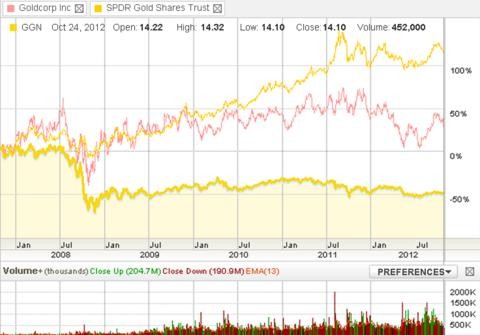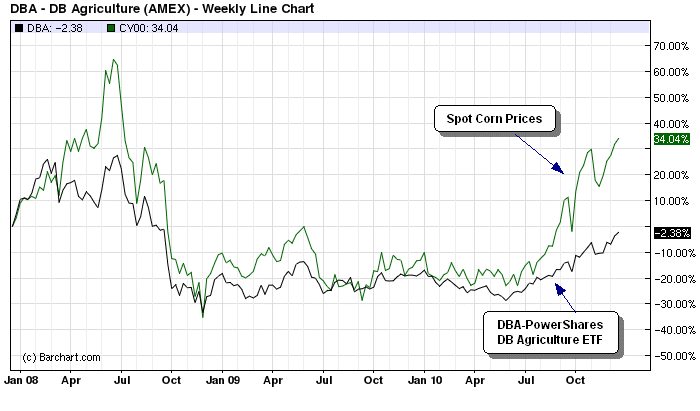Top ETFs and What They Track
Post on: 8 Август, 2015 No Comment

Commodities are an example of an asset class that was less accessible to retail investors until recent years. Prior to the advent of ETFs, commodity investors were broadly limited to the futures market.
Commodity prices usually rise when inflation is accelerating, making them an important hedge against rising prices, potentially protecting the purchasing power of investor capital.
Commodities are also valuable in terms of diversification. Bonds are only minimally correlated with stocks, making them an effective tool in diversifying investments. Commodities provide even further diversification in that they have been negatively correlated to both stocks and bonds historically.
Commodities such as gold are also often looked to as safe havens in periods of geopolitical uncertainty.
SPDR Gold Shares
State Street Global Advisors introduced the first gold ETF in November 2004, called SPDR Gold Shares (NYSE:GLD).
The fund was designed to track the spot price of gold bullion. Each share represents ownership in one tenth of an ounce of gold held by the fund.
The SPDR Gold Shares is physically backed, meaning that the shares they issue are backed by their holdings of the precious metal. The gold is held in HSBC’s vault in London.
As the price of gold rises or falls, GLD moves up or down. Key factors that influence the price movement in gold prices include the level of production, the level of demand, the value of the U.S. dollar and central bank policy.
One of the largest ETFs in the world, as of 2013 GLD has over $33 billion in net assets under management.
The fund is has an average daily volume of over 8 million shares. The expense ratio of 0.40% is substantially higher than the stock index ETFs covered earlier. (To learn more about gold ETFs, read The Gold Showdown: ETFs vs. Futures)
iShares Silver Trust
The second largest ETF covering a single commodity is the iShares Silver Trust (NYSE:SLV). Launched in 2006 and managed by BlackRock, the iShares Silver Trust is designed to track the spot price of silver bullion.
In comparison to gold, silver has many industrial uses and its price is more volatile due to having a smaller market size.
Similar to GLD, a share of SLV represents ownership of slightly less than one ounce of silver. Major factors influencing the price of silver include industrial and consumer demand, the value of gold and the value of the U.S. Dollar.
Considerably smaller than the SPDR Gold Trust, as of 2013 the iShares Silver Trust has assets under management of over $6 billion, an average daily volume of over 8 million shares, and an expense ratio of 0.50%.
United States Oil Fund LP
Crude oil, sometimes called black gold is another of the most important and closely watched commodities in the world.
As of 2013, the United States Oil Fund (NYSE:USO) is the largest crude oil ETF by assets under management and average daily volume of contracts traded.
Launched in 2006, the fund tracks the price of light, sweet crude oil futures traded on the New York Mercantile Exchange (NYMEX, owned and operated by CME Group).
In many cases, such as the United States Oil Fund, ETFs invest in the futures market due to the high levels of liquidity available.
NYMEX light sweet crude oil futures are the worlds most liquid crude oil benchmark and the worlds most actively traded energy product.
Factors that influence the price of crude oil include supply in terms of output, the level of oil reserves, the level of demand and geopolitical news. Rising levels of output and reserves tend to force crude oil prices lower, while declining levels push the price of crude oil higher. Geopolitical news and events, particularly out of the Middle East, can influence the price of oil. A perceived threat to levels of supply will push oil prices higher.

The fund is much smaller than GLD or SLV, with assets under management of approximately $1.2 billion as of November 2013. USO has an average daily volume of over 5 million shares and an expense ratio of 0.45%.
United States Natural Gas Fund LP
The United States Natural Gas Fund (NYSE:UNG), launched in 2007, is another major ETF in the energy sector. The fund tracks NYMEX natural gas futures, the most liquid natural gas contract.
Factors that influence the price of natural gas include production levels, imports, underground storage levels, seasonal weather and petroleum prices. As with crude oil, increases in the level of production and reserves will typically pressure the price of natural gas lower and vice versa for decreasing levels. The weather and petroleum prices affect levels of demand. Petroleum is viewed as a potential substitute for natural gas in some cases.
As of November 2013, the fund has assets under management of over $1 billion, an average daily volume of over 4 million shares and an expense ratio of 0.60%.
Powershares DB Commodity Index Tracking Fund
Launched in 2006, the Powershares DB Commodity Index Tracking Fund (NYSE:DBC) provides an option for investors looking to invest in a basket of commodities.
The fund tracks the DBIQ Optimum Yield Diversified Commodity Index, made up of futures contracts on 14 of the most liquid physical commodities in the world, covering energy, agriculture, and metals. The commodities included in the index are light sweet crude oil (WTI), heating oil, RBOB gasoline, natural gas, Brent crude, gold, silver, aluminum, zinc, copper corn, wheat, soybeans, and sugar.
Major factors that influence the prices of commodities as a whole include supply and demand, levels of stock, currency exchange rates and the level of inflation.
As of November 2013 the fund has assets of over $5 billion, an average daily volume of over 1.6 million shares. And an expense ratio of 0.93%.
The Bottom Line
The rapid expansion of the ETF universe bears testimony to their popularity with investors and their effectiveness in enabling broad ranging asset allocation. ETFs provide a versatile and cost-efficient portfolio diversification vehicle for both small and large investors alike. Importantly, in contrast to mutual funds, the high level of transparency offered by ETFs empowers investors, in that they can have a more clear understanding of what they are investing in.














